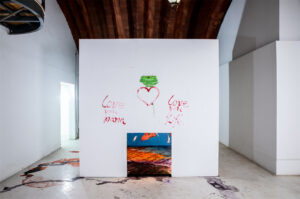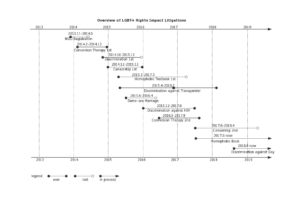Sprint4_Week9#The Common: Problem Senario
‘…consider how the arts and contemporary theory structure “the commons” anew: how the commons becomes both a goal and a trope in post-millennial art and cultural theory.’ (Amy J. Elias)
1/ There is a common saying in China that hard circumstances produce bad folk. When we are unable to recognise the art, our minds feel obstructed. I believe that art is more like an approach that can unleash the force from inside to appreciate the beauty of the physical world with mercy rather than an object or a type of thinking. A shared serenity and communal thought can be produced by the mercy of the artistic viewpoint. We felt it necessary to revive the common rather than remain in “our own land” as a result. Art can help us reclaim a wholeness of mind and emotion, breaking down the boundaries of culture and consciousness — a valuable step in reclaiming the commons.
A physical area was built for Queer groups to communicate with the general public and the social community as part of our own Basho’s work about the Queer Common. We took into account Chinese policy in order for it to be displayed as a gallery showcasing the works of queer artists exploring their identities. It served as a vehicle for both universal expression and a display of the artistic creativity sparked by gender disparities.
2/ As my research, I found that common art began in 1999 by a group of un-housed men and women with the assistance of ministers from St. John the Evangelist Church on Bowdoin Street. As a unique opportunity within the city of Boston, one participant expressed, “common art is famous! Everybody knows about it on the street!” Our Basho’s theme – Queer common, there also had a first test gallery in China’s X museum. The gallery was created by a Chinese artist whose name was Sida Jiang. He built a place named Love Me(Fu*king me).
Jiang’s ‘F*ck me’ tells a tale of his emotional battles through a series of work, and also answers the paradox and obstacles listed above. ‘F*ck me’ is not only an act of the artist’s inner ambition, but also a performance which allows Jiang to drag many hidden faces behind their screens into a physical space he created and get fully vibrated. X Museum is proud to present Sida Jiang’s first solo exhibition in an institution, where boundaries between the self and the public in this post-internet era will be discussed through a series of works from 2020, including installations, films, performances, paintings and mixed media works, etc.

There was an interesting and meaningful idea in this gallery named Queen.
The live art performance ‘Queen’ is a highlight of this exhibition. Freeing people’s mind and taking off those restrictive factors which might prevent people from connecting to each other, this interactive game-like performance encourages people to meet and interact. Inspired by the online social networking apps, artist took the online networking space down to our physical space and tried to utilize the ‘Match and Date’ game to explore the boundaries between our personal and public space in the Post-Internet era. In this live performance, artists invited many performers to join and act as “Queens”. Every Queen has their unique personalities. Meet, chat, match and say goodbye, the Queen pulls the audience back to the reallife from the cyber pace.
‘Love me’ is not only the artist’s cross-boundary experimental showcase, but is also the redefinition of human relationships and social contracts. Humans are born to be equal and born to be free. Love ourselves, love others, in the common.
3/ Actually there’s a website as the common for LGBTQ+group’s rights, named Queerc in China. Here is a form about LGBTQ+’s impact litigation:

In the last few years, LGBT+ people in China witnessed highs and lows, or we have developed a new perspective on how to views. There are times when you sow, plough and harvest. Hope the seeds they sowed and ploughed in the past few years, will give them a plentiful harvest in the future. Here is a map or list of queer’s act in China.
From:
FANG, Gang: Associate Professor of the Department of Applied Psychology, Beijing Forestry University, mainly researching sexology and sexual psychology.
Guo Xiaofei (GUO, Xiaofei): Associate Professor at the Law School of China University of Political Science and Law, specializing in constitutional law and jurisprudence.
LIU, Xiaonan: Professor at the Institute of Human Rights, China University of Political Science and Law, specializing in anti-discrimination law.
WEI, Wei: Associate Professor, Department of Sociology, East China Normal University, specializing in sociology.
LIU, Wenli is a professor at Beijing Normal University specializing in sex education, health education and promotion.
There’s also an useful link for me and our Basho to research: https://cnlgbtdata.com, it is about Chinese policy and laws in LGBTQ+ group.
4/ During the research, our Basho collected different kinds of galleries, datas and materials, we found that more LGBTQ+ group believe that they were born in this way. Located in northwestern China, Xianyang has a population of about 7 million (Census Bureau, 2019), making it by no means a large city in China. There are no gay bars or clubs here. The only way to meet other queer people is to go to the nearest big city, Xi’an, or open the same-sex dating app Blued. So it is hard to have a widely and deeply research during Chinese queer group. So our research was based on the exist finds and works in this filed, which could help us to learn more.
5/ Now in China, the commons are common in most of themes, but may not Queer theme.
In the late 1990s, Li Yinhe, a sociologist and sexology scholar and activist, adopted this “cool child” in his translation of Queer Theory: Western Sexual Trends in the 90s, bringing him into the world of Chinese Simplified for the first time. The term is used to refer to sexual orientation or gender identity in society, non-heterosexual people such as gay, bisexual, and transgender people, and the concept of “queer” has become an exclusive category in the field of film research in the West.
Due to changes in the social environment, the development of queer art in China has also shown different states at different times. Previously, due to the influence of social conditions and traditional factors, the social reality in China and the West was very different, and the spread of queer art in China was greatly restricted, and artists would not “go against the wind” to hype queer art. But now that the social atmosphere is becoming more and more open, coupled with the integration of Western ideas, young artists have begun to express queer art in their own way, challenging the heterosexual system and heterosexual hegemony in mainstream culture, aiming to break through the prison that suppresses people’s free choice.
For my reflection: the increasing visibility and expanding public space of the gay community in urban society reflect the positive changes that have taken place in China’s cities and society. Queer art is still in the initial stage of development in China, it is sexy and subversive, but its expression and acceptance need to be further developed and improved.
6/ Limitation:
a. After the 90s, the words “gay”, “gay”, “queer” were born under very short historical conditions. These words have all had an impact on Chinese society, so we have both gay literature, gay literature, even queer literature and so on, and they actually have subtle differences. But overall, these concepts are mixed in China and are one of the unique features that ‘make uour queer culture.
b. The expression of sexuality in politics and movement is very limited. It actually has more to do with the past imagination of homosexuality. Homosexuality is a product of stigmatization in the Chinese context, both as a “pathology” and a subjective identity before “decriminalization”. This subjective identity occupies a large part of our urban space, and in the imagination of the queer community in the city, it is a very important group of people, an important imagination, an important way of life, and society should give these lifestyles a certain space. So in this sense, we need to consider the connections between these spaces, which can be both imaginary, physical, and emotional spaces, while also paying attention to the context of globalization, urbanism, consumerism in which these spaces are located, and the uncertainty of these common.
Possibility:
Queer common and art have also had a huge impact on popular culture. The shocking and rebellious temperament of queer art that ignores mainstream rules coincides with the extreme pursuit of beauty in the fashion industry. Queer art imprints itself deeply in fashion elements, transcending genders and breaking boundaries. I think it is also a kind of possibility to build a new view in public to know queer and create the common for them.




This really is a very thought provoking post. In this post I see that JiaDing has done a lot of information gathering and analytical research. I can see very clearly the depth of the Queer theme, so reading this post also made me think about the relationship between Queer, Commons and social development. Thank you very much to the author for sharing this, I have learnt a lot.